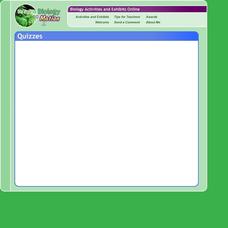Curated OER
So You Think You're Tough
Fourth graders learn how to classify animals. In this invertebrates lesson, 4th graders discuss how we classify thinks into groups and move into a discussion about classifying animals. Students learn about the differences between...
Curated OER
Animal Playing Cards
Learners research animal characteristics including information about mammals, reptiles, birds, and fish. They place the information into a database and then, create playing cards using the information.
Starfall
Short E - Classification (Animal, Thing)
For this language arts worksheet, students practice classifying the nouns into the right category. They also use the pictures as clues to meaning.
Curated OER
Right Triangles
Learners classify triangles and make connections regarding angle measurements and attributes of acute, right, and obtuse triangles. They listen to teacher define and explain triangles. Everyone imagines a place where a broken wing for a...
ARKive
Species Discovery
How many of your students know that even today new species are being found all over the globe? Introduce them to the amazing diversity our planet houses with a creative activity about animal variation and classification. They'll use a...
Curated OER
Sorting
Students identify how objects can be sorted or classified for easy access. In this sorting activity, students will investigate how letters, numbers, and symbols are used in sorting and classifying.
Curated OER
Scalene Triangles
Fifth graders identify and classify scalene, equilateral, and isosceles triangles. In this triangle instructional activity, 5th graders define the different attributes of 3 types of triangles and sort them by descriptions and...
Curated OER
Who's Who? Integrated Core
Student discuss names and nicknames for human and animal families and complete a worksheet, matching pictures of father, baby and mother animals.
Curated OER
Geometry Fun
Young scholars learn the basic definitions of a quadrilateral, parallelogram, rectangle and square and explain the relationship/classification process between them.
Curated OER
Camouflage
First graders learn how plants and animals adapt to their environments. In this camouflage instructional activity, 1st graders watch a movie that explains animal camouflage, design a butterfly that blends into a classroom habitat,...
Curated OER
Who's There
Fifth graders, in groups, make a list of at least three animals that would survive well in a particular environment. After an allotted time, they pass their list to another group, where they will add to it. They discuss adaptations each...
Curated OER
Acute Triangles
Learners study acute triangles. They measure angles using a protractor, then classify the triangles as either right, obtuse, or acute. Everyone creates a design for a Navajo rug using only acute triangles.
Biology in Motion
Organize-It
Many pupils struggle to categorize and organize related content. Multiple quizzes on a variety of topics offer practice for these specific skills. Scholars move items around until they think each is placed in the proper position....
Curated OER
Arthur's Eyes
Students learn about the parts of the eye. In this eyes and vision lesson, students the story Arthur's Eyes and create a KWL chart about eyes. Students label the parts of the eye, examine the eyes of different animals to compare them...
Curated OER
How Animals Prepare for Winter
Second graders study which animal hibernate and which migrate. They observe the weather conditions related to each and complete the associated worksheets and web activity.
Alabama Learning Exchange
It's a Small, Small World
Middle schoolers compare and contrast the different characteristics of animal-like, plant-like, and fungus-like protists. They list examples and describe the characteristics shared by the three protist groups. They create a brochure or...
Curated OER
Discovering the Deep
Students explore the world's oceans. They research questions about the oceans and write a research report about an ocean animal. Students identify at least four different writing genres they experienced while reading about the ocean.
Curated OER
Under The Sea
In this resource lesson plan, students use non-fiction books to research ocean animals. Students discover the many features of non-fiction books and how to use these features to help them conduct research. Students then categorize ocean...
Curated OER
Isosceles Triangles
Students investigate triangles. In this shapes geometry lesson, students define and state the attributes for equilateral, scalene, and isosceles triangles. Students locate the prefix "tri" in a variety of words and make connections with...
Curated OER
Show Some Backbone and Teach Invertebrates
Fifth graders identify two similarities and two differences between two phyla, assign fictitious invertebrate to its phylum and explain why it belongs in that grouping, and construct member of given phylum and explain why it should be...
K5 Learning
Musical Instruments to Play
Bring some music to your language arts lesson with a reading comprehension activity. Learners read an informational passage about different musical instruments before answering a series of comprehension and vocabulary questions.
Curated OER
Farm Babies
Students use flash cards to match the mother names to the baby names for farm animals. In a designated "barn" in the room, students simulate being mothers, fathers, and babies. The baby must find his mother and father. Students visit...
Curated OER
Quadrilateral Characteristics
Fourth graders explain the characteristics of quadrilaterals and describe, identify and analyze characteristics and properties of geometric shapes.
Curated OER
3-D Figures Part 1
Elementary schoolers explore 3-D shapes. They transition from thinking of shapes as only 2-D. Pupils read Cinderella as a launching activity for their upcoming adventure, and explore a new world of 3-D shapes in this introductory...
Other popular searches
- Plant Animal Classification
- Animal Classification System
- Animal Taxonomy Game
- Animal Classification Test
- Animal Classification Fish
- Animal Classification Units
- Classifying Animals Chart
- Diversity of Animal Kingdom
- Animal Classification Lesson
- Classifying Animal Groups
- 5e Animal Classification
- Science Classifying Animals

























